TOYOTA 4RUNNER 1998 Workshop Manual
Manufacturer: TOYOTA, Model Year: 1998, Model line: 4RUNNER, Model: TOYOTA 4RUNNER 1998Pages: 350, PDF Size: 2.25 MB
Page 51 of 350
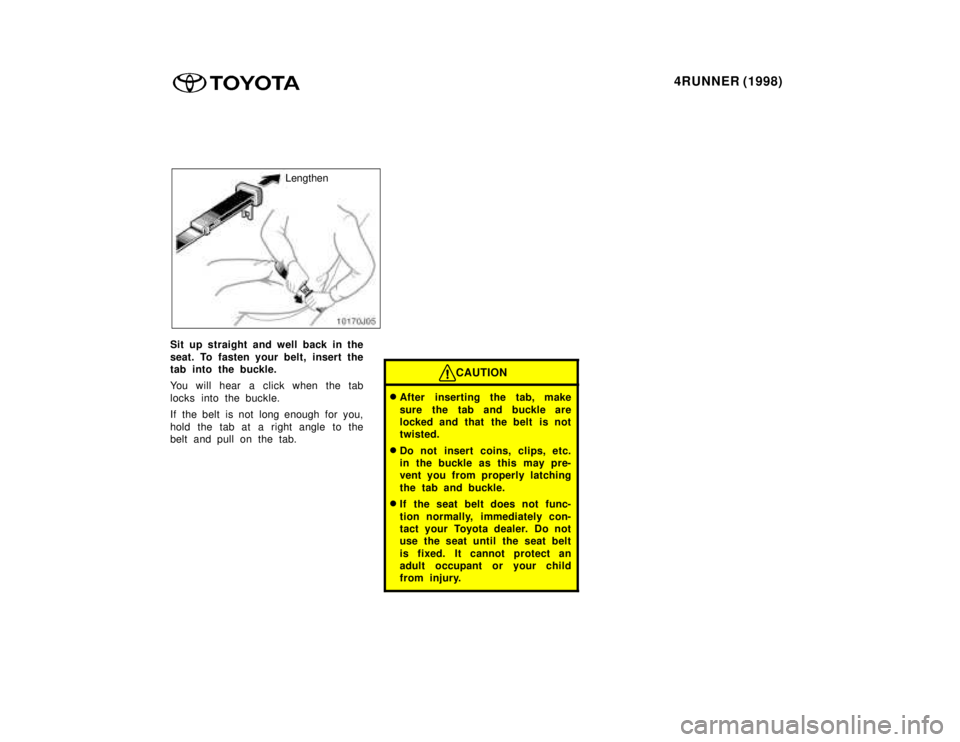
4RUNNER (1998)
Lengthen
Sit up straight and well back in the
seat. To fasten your belt, insert the
tab into the buckle.
You will hear a click when the tab
locks into the buckle.
If the belt is not long enough for you,
hold the tab at a right angle to the
belt and pull on the tab.
CAUTION
� After inserting the tab, make
sure the tab and buckle are
locked and that the belt is not
twisted.
� Do not insert coins, clips, etc.
in the buckle as this may pre-
vent you from properly latching
the tab and buckle.
� If the seat belt does not func-
tion normally, immediately con-
tact your Toyota dealer. Do not
use the seat until the seat belt
is fixed. It cannot protect an
adult occupant or your child
from injury.
Page 52 of 350
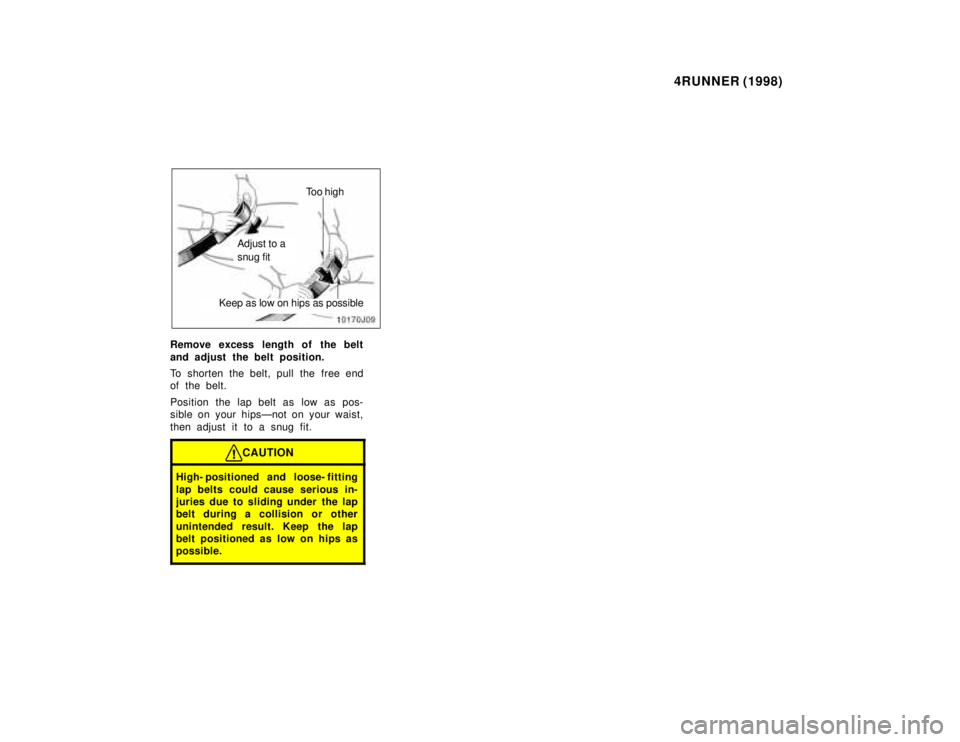
4RUNNER (1998)
Too high
Adjust to a snug fit
Keep as low on hips as possible
Remove excess length of the belt
and adjust the belt position.
To shorten the belt, pull the free end
of the belt.
Position the lap belt as low as pos-
sible on your hipsÐnot on your waist,
then adjust it to a snug fit.
CAUTION
High- positioned and loose- fitting
lap belts could cause serious in-
juries due to sliding under the lap
belt during a collision or other
unintended result. Keep the lap
belt positioned as low on hips as
possible.
Page 53 of 350
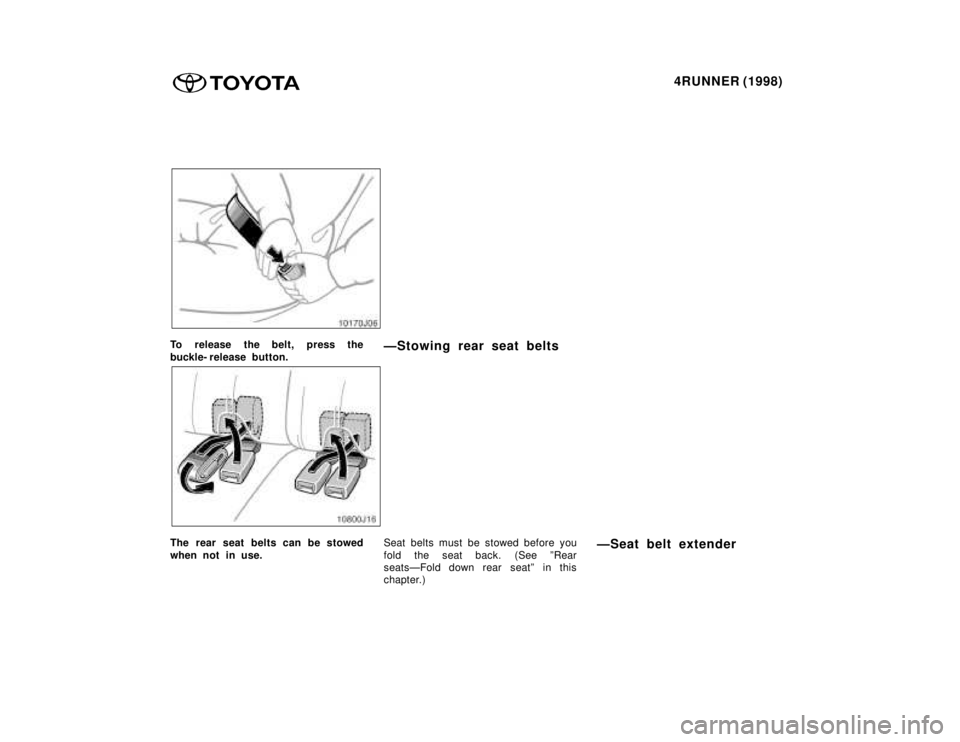
4RUNNER (1998)
To release the belt, press the
buckle- release button. ÐStowing rear seat belts
The rear seat belts can be stowed
when not in use.Seat belts must be stowed before you
fold the seat back. (See ºRear
seatsÐFold down rear seatº in this
chapter.)ÐSeat belt extender
Page 54 of 350

4RUNNER (1998)
If your seat belt cannot be fastened
securely because it is not long enough,
a personalized seat belt extender is
available from your Toyota dealer free
of charge.
Please contact your local Toyota deal-
er so that the dealer can order the
proper required length for the extend-
er. Bring the heaviest coat you expect
to wear for proper measurement and
selection of length. Additional ordering
information is available at your Toyota
dealer.
CAUTION
When using the seat belt extend-
er, observe the following. Failure
to follow these instructions could
result in less effectiveness of the
seat belt restraint system in case
of vehicle accident, increasing the
chance of personal injury. � Never use the seat belt extend-
er if you can fasten the seat
belt without it.
� Remember that the extender
provided for you may not be
safe when used on a different
vehicle, or for another person
or at a different seating posi-
tion than the one originally in-
tended for.
3SRS driver and front
passenger airbags
Page 55 of 350
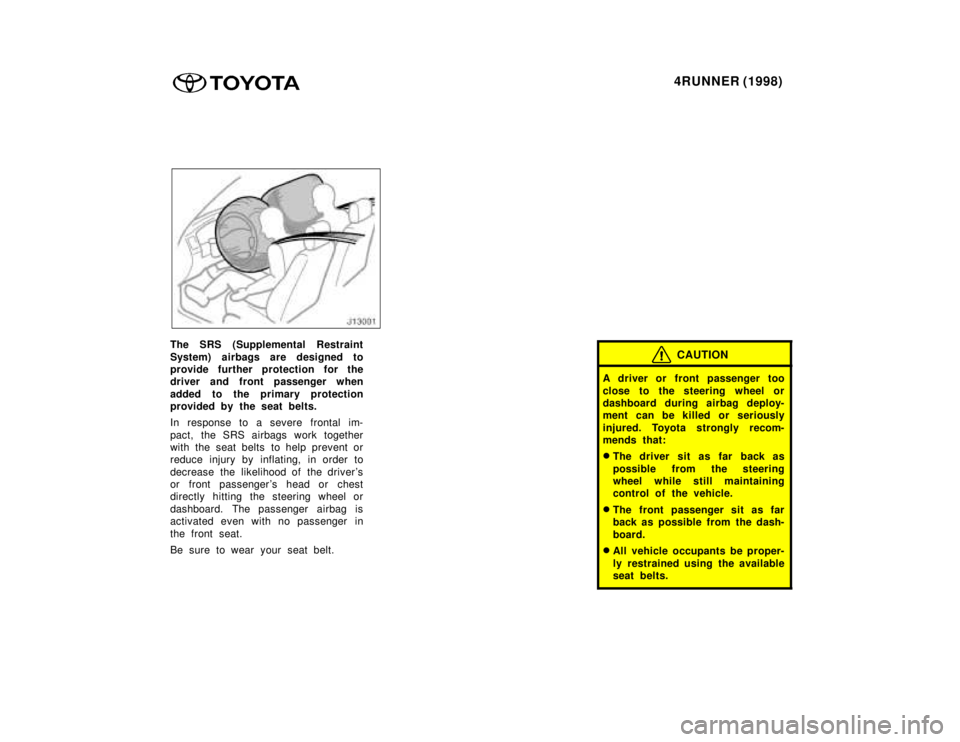
4RUNNER (1998)
The SRS (Supplemental Restraint
System) airbags are designed to
provide further protection for the
driver and front passenger when
added to the primary protection
provided by the seat belts.
In response to a severe frontal im-
pact, the SRS airbags work together
with the seat belts to help prevent or
reduce injury by inflating, in order to
decrease the likelihood of the driver 's
or front passenger 's head or chest
directly hitting the steering wheel or
dashboard. The passenger airbag is
activated even with no passenger in
the front seat.
Be sure to wear your seat belt.CAUTION
A driver or front passenger too
close to the steering wheel or
dashboard during airbag deploy-
ment can be killed or seriously
injured. Toyota strongly recom-
mends that: �The driver sit as far back as
possible from the steering
wheel while still maintaining
control of the vehicle.
� The front passenger sit as far
back as possible from the dash-
board.
� All vehicle occupants be proper-
ly restrained using the available
seat belts.
Page 56 of 350
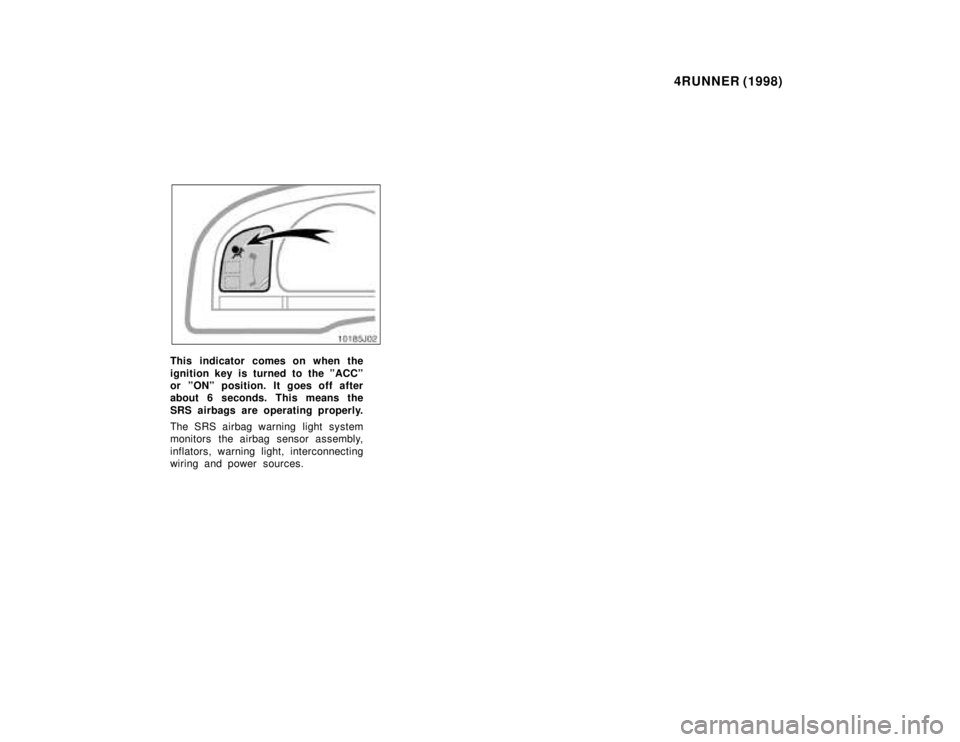
4RUNNER (1998)
This indicator comes on when the
ignition key is turned to the ºACCº
or ºONº position. It goes off after
about 6 seconds. This means the
SRS airbags are operating properly.
The SRS airbag warning light system
monitors the airbag sensor assembly,
inflators, warning light, interconnecting
wiring and power sources.
Page 57 of 350
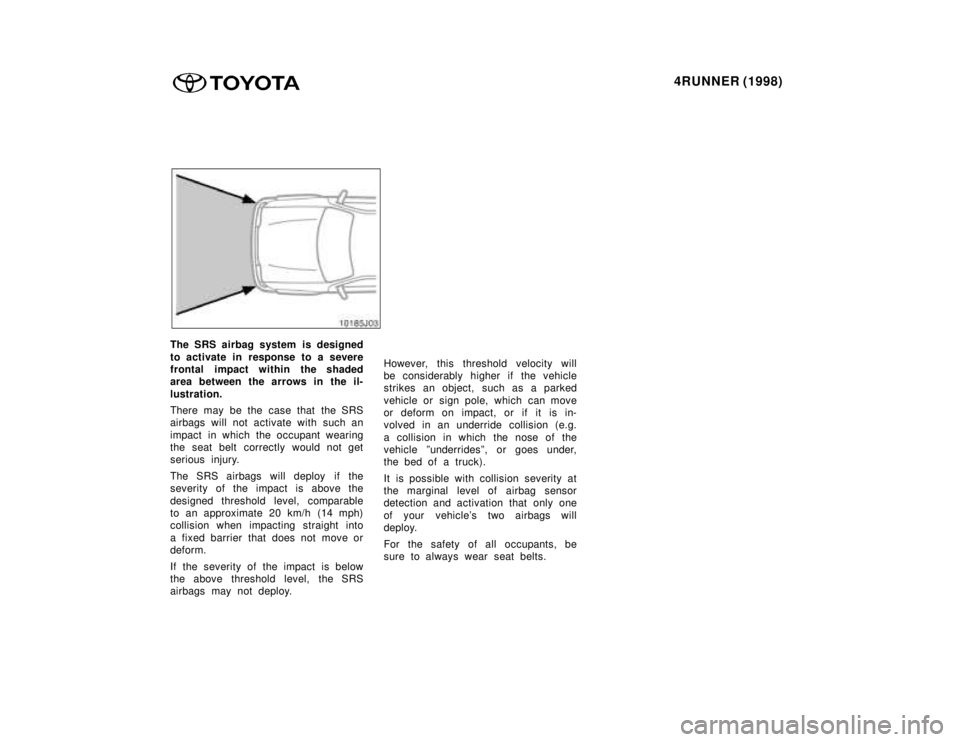
4RUNNER (1998)
The SRS airbag system is designed
to activate in response to a severe
frontal impact within the shaded
area between the arrows in the il-
lustration.
There may be the case that the SRS
airbags will not activate with such an
impact in which the occupant wearing
the seat belt correctly would not get
serious injury.
The SRS airbags will deploy if the
severity of the impact is above the
designed threshold level, comparable
to an approximate 20 km/h (14 mph)
collision when impacting straight into
a fixed barrier that does not move or
deform.
If the severity of the impact is below
the above threshold level, the SRS
airbags may not deploy. However, this threshold velocity will
be considerably higher if the vehicle
strikes an object, such as a parked
vehicle or sign pole, which can move
or deform on impact, or if it is in-
volved in an underride collision (e.g.
a collision in which the nose of the
vehicle ºunderridesº, or goes under,
the bed of a truck).
It is possible with collision severity at
the marginal level of airbag sensor
detection and activation that only one
of your vehicle's two airbags will
deploy.
For the safety of all occupants, be
sure to always wear seat belts.
Page 58 of 350

4RUNNER (1998)
Collision from the side Collision from the rear
Vehicle roll- over
The SRS airbags are not designed
to inflate if the vehicle is subjected
to a side or rear impact, if it rolls
over, or if it is involved in a low-
speed frontal collision.
Page 59 of 350
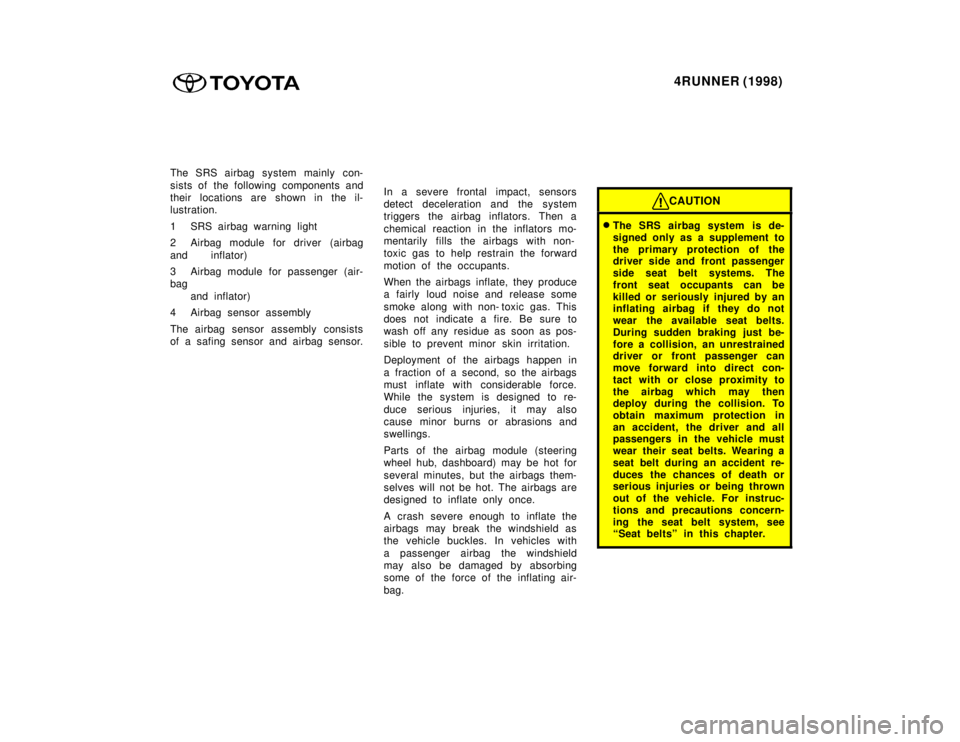
4RUNNER (1998)
The SRS airbag system mainly con-
sists of the following components and
their locations are shown in the il-
lustration.
1 SRS airbag warning light
2 Airbag module for driver (airbag
and inflator)
3 Airbag module for passenger (air-
bag
and inflator)
4 Airbag sensor assembly
The airbag sensor assembly consists
of a safing sensor and airbag sensor. In a severe frontal impact, sensors
detect deceleration and the system
triggers the airbag inflators. Then a
chemical reaction in the inflators mo-
mentarily fills the air
bags with non-
toxic gas to help restrain the forward
motion of the occupants.
When the airbags inflate, they produce
a fairly loud noise and release some
smoke along with non- toxic gas. This
does not indicate a fire. Be sure to
wash off any residue as soon as pos-
sible to prevent minor skin irritation.
Deployment of the airbags happen in
a fraction of a second, so the airbags
must inflate with considerable force.
While the system is designed to re-
duce serious injuries, it may also
cause minor burns or abrasions and
swellings.
Parts of the airbag module (steering
wheel hub, dashboard) may be hot for
several minutes, but the airbags them-
selves will not be hot. The airbags are
designed to inflate only once.
A crash severe enough to inflate the
airbags may break the windshield as
the vehicle buckles. In vehicles with
a passenger airbag the windshield
may also be damaged by absorbing
some of the force of the inflating air- bag.
CAUTION
� The SRS airbag system is de-
signed only as a supplement to
the primary protection of the
driver side and front passenger
side seat belt systems. The
front seat occupants can be
killed or seriously injured by an
inflating airbag if they do not
wear the available seat belts.
During sudden braking just be-
fore a collision, an unrestrained
driver or front passenger can
move forward into direct con-
tact with or close proximity to
the airbag which may then
deploy during the collision. To
obtain maximum protection in
an accident, the driver and all
passengers in the vehicle must
wear their seat belts. Wearing a
seat belt during an accident re-
duces the chances of death or
serious injuries or being thrown
out of the vehicle. For instruc-
tions and precautions concern-
ing the seat belt system, see
Seat beltsº in this chapter.
Page 60 of 350
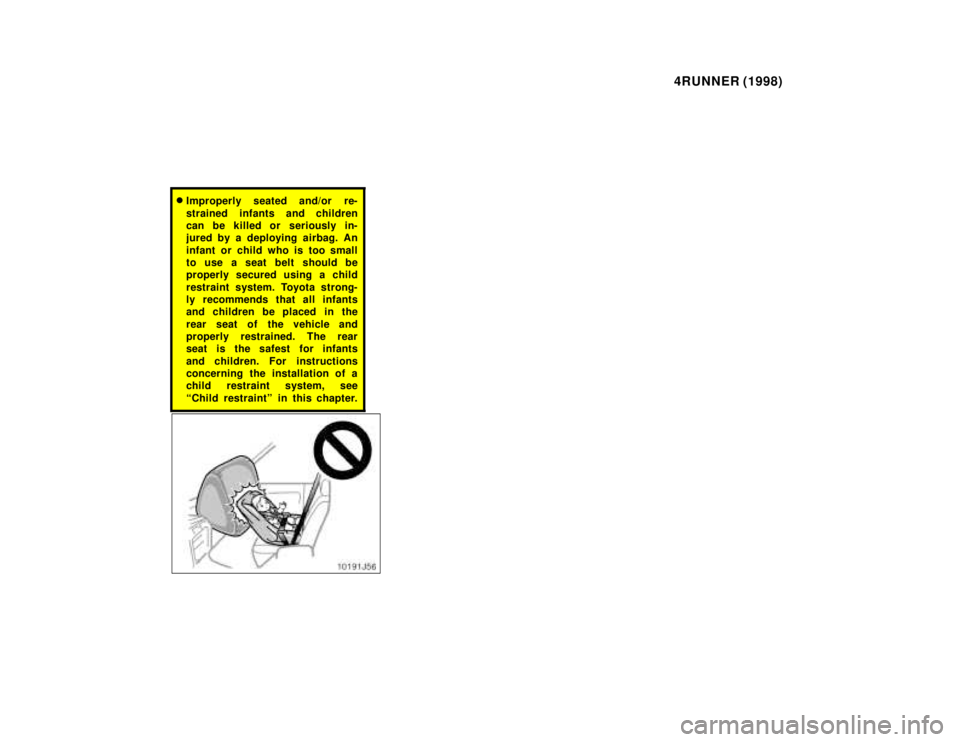
4RUNNER (1998)
�Improperly seated and/or re-
strained infants and children
can be killed or seriously in-
jured by a deploying airbag. An
infant or child who is too small
to use a seat belt should be
properly secured using a child
restraint system. Toyota strong-
ly recommends that all infants
and children be placed in the
rear seat of the vehicle and
properly restrained. The rear
seat is the safest for infants
and children. For instructions
concerning the installation of a
child restraint system, see
Child restraintº in this chapter.